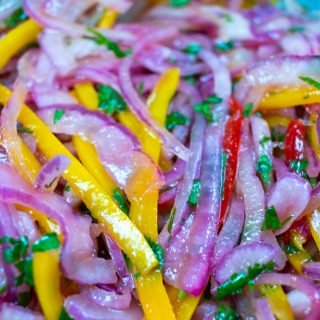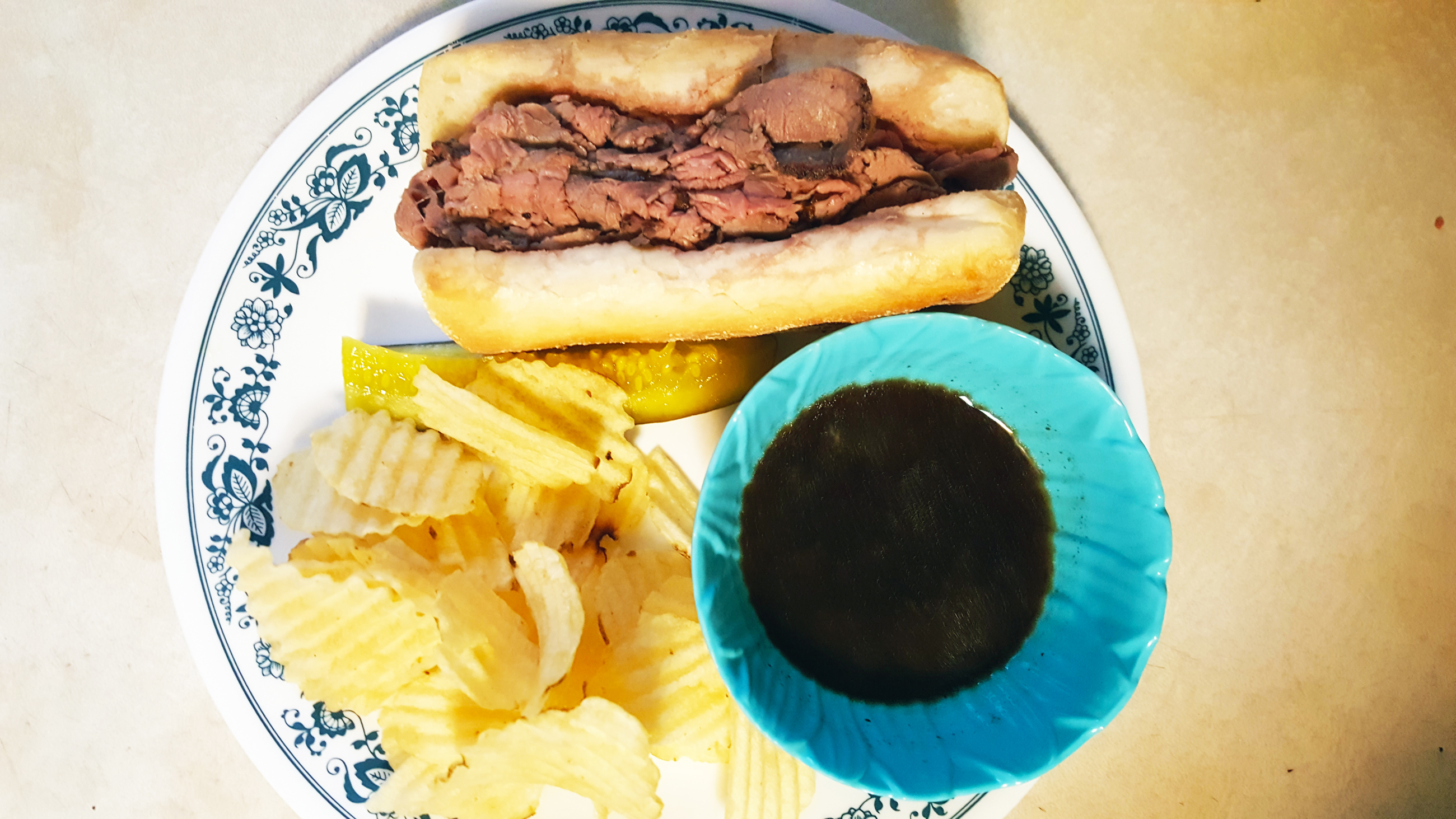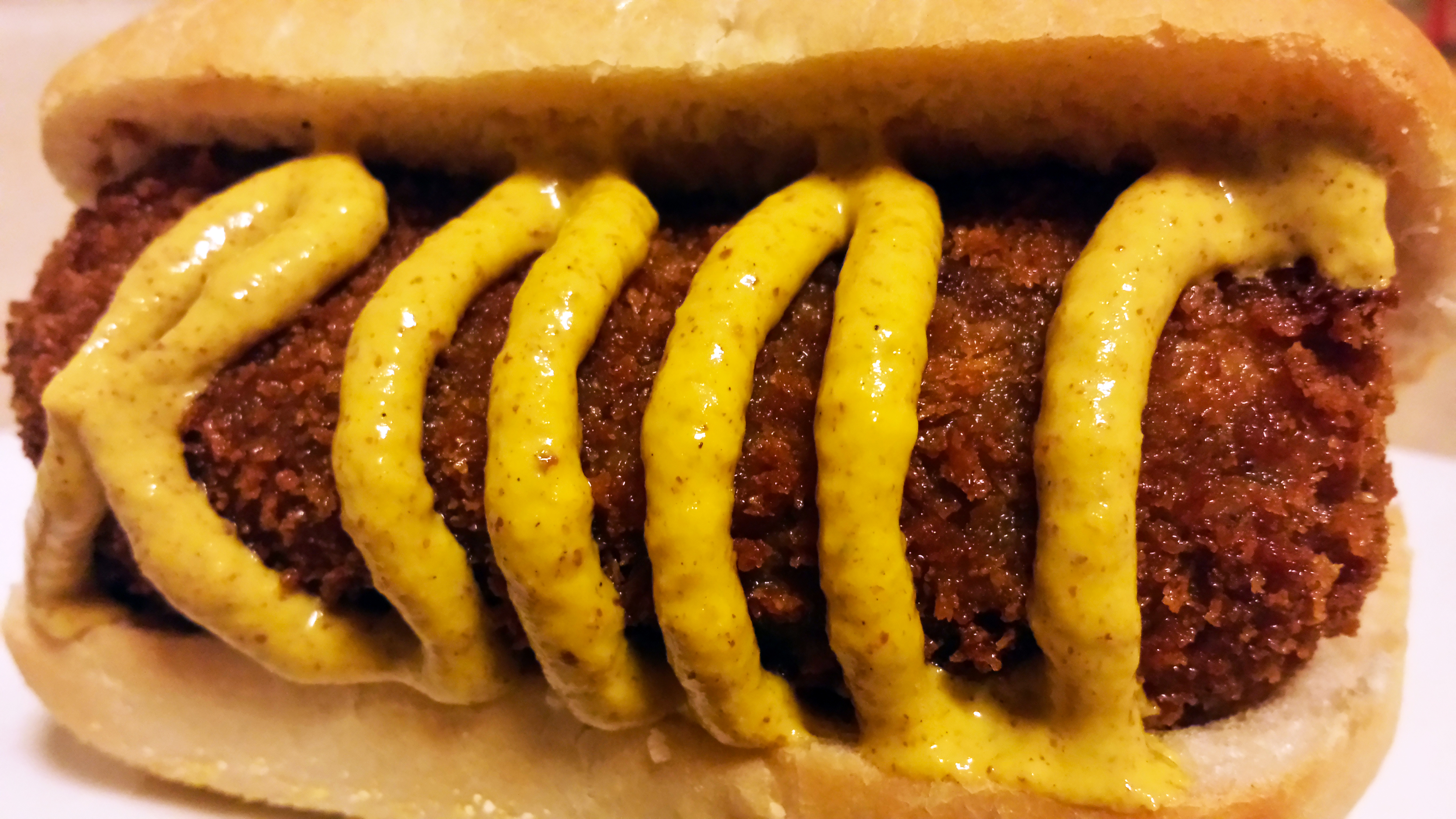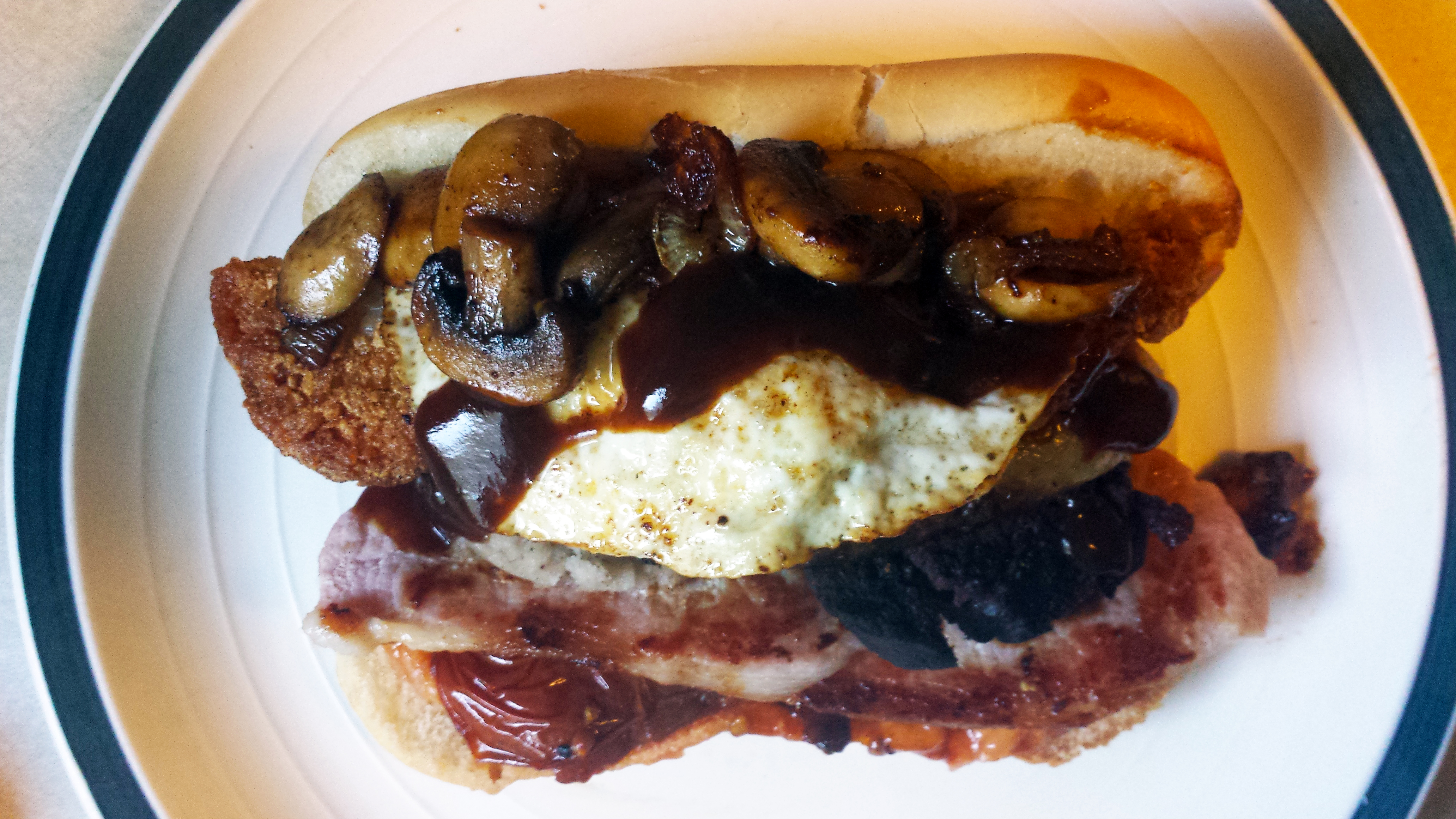The Buns of Chicharrón: Peru’s Crispy Pork Sandwich
Pan con chicharrón is a Peruvian breakfast sandwich consisting of crisp fried pork with fried slices of sweet potato and a type of quick-pickled onion condiment called salsa criolla in soft bread rolls. Pan is Spanish for bread, as in a bread roll or bun, con means with, and chicharrón of course, rhymes with Navarone, leading to this post’s very dumb title.
The Spanish word chicharrón derives from the word achicharrar, meaning to scorch, or burn to a crisp. An apt root word–culinarily, chicharrón refers usually to skin-on pork belly that is slowly cooked and then deep-fried, rendering much of the fat from the meat and puffing the skin up into something resembling a slightly harder, crunchier version of American-style pork rinds that you can buy in a bag, coated in powdered hot sauce. Chicharrón does not always reference pork belly–chicharrónes de pollo is a phrase used to describe fried chicken in multiple Latin American countries, and can reference fried fish in multiple South American countries, the crisp fried skin of various food animals in the parts of the Phillipines, and even a wagon wheel shaped wheat-based crisp eaten as a snack in Mexico that is entirely vegetarian!
A Nosh In The Park
The sandwich is actually offered on at least one Chicagoland menu, so I took the opportunity to have a long-overdue lunch with friend of the site Eric May and try the Chicharrón sandwich from SanguCHE in Naperville.

I’d been meaning to get to SanguCHE for a while–pre-pandemic, they had offered the Butifarra, a Peruvian sandwich I wrote about last summer. During those days of Covid closedowns, a time when many businesses could offer curbside service only, SanguCHE like many restaurants simplified their menu, cutting down to a few sandwiches only, and removing the butifarra. I was not able then to try their take on it, but this time around they were serving it and I enjoyed a 2-sandwich lunch as a result. We ordered and then enjoyed our lunch at the gazebo in nearby Country Lakes Park.

The Butifarra featured slices of lean pork–I suppose this is jamon del pais, and there is a yellowish tint to the edges of the meat and bleeding into the bread suggestive of the annatto slather used in preparing that dish. The jamon was served in a fairly nondescript foodservice ciabatta with tomato, some thin strands of something slawlike that is likely salsa criolla, and a green sauce that could be aji verde. It was not a bad sandwich at all, the bread crisply griddled and the proportions reasonable. It didn’t excite me the way my own attempts at butifarra had though.

Better yet was SanguCHE’s Chicharrón sandwich. Also served on the well-griddled ciabatta bread, once again the sandwich demonstrated restraint in the ingredient amounts, with a less prominent presence of salsa criolla than I’d like. The dark pork, less fatty than I’d normally expect a pork belly product like chicharrón to be (a larger portion of rib meat attached I thought–more on that later), had great flavor though, especially when combined with the thin slices of sweet potato, and the green sauce I suspected to be aji verde added a little chili heat, a little cilantro brightness, a little creamy/tangy mayonnaise-like quality.
DIY ‘Til I Die
I like salsa criolla far too much to pass up an excuse to make it at home though. Salsa criolla or “Creole sauce” differs from place to place in Latin America–in Colombia it is a cooked mixture of tomatoes, onions, and peppers flavored with cumin and achiote; in Argentina, a minced combination of tomatoes, onions, and mild peppers similar to pico de gallo; in Puerto Rico salsa criolla is a sofrito-based tomato sauce. The Peruvian version, which I adore, consists of long thin strips of red onion and some of the signature yellow chiles of Peruvian cuisine, quick-pickled in lime juice and salt and dressed with chopped cilantro and olive oil. I can’t get real aji amarillo locally so instead I used sweet yellow peppers (for the look of the thing) along with some ripe serranos and aji amarillo paste to add a little heat.

Salsa Criolla v2
Ingredients
- 1 red onion sliced thin on a mandoline
- 2 limes
- 1 tsp kosher salt
- 2 small yellow sweet peppers sliced into thin strips
- 1/4 cup cilantro chopped, leaves and small stems
- 2 ripe red serrano peppers sliced into thin strips
- 1 tsp aji amarillo paste
- 2 tbsp olive oil
Instructions
- After slicing the onions and peppers, combine in a bowl. Add the juice of 2 limes and a tsp of salt. Mix thoroughly
- Add aji amarillo paste, cilantro, and olive oil. Mix thoroughly
- Allow flavors to meld in refrigerator for at least 30 minutes and up to overnight.
Rather than ciabatta, pan con chicharrón is usually served in pan francés, a type of baguette-derived bread roll common throughout Latin America. The pan francés used for this sandwich can be round or slightly oblong/oval. My own attempts at making pan francés have been a mixed bag–decent enough bread, usually, but not always what I expected nor necessarily perfect for making sandwiches. And yet here I am, trying again after watching a Youtube video on making Peruvian pan francés.

They’re not perfect–this recipe calls for rolls around 60g in size, which end up being smaller than what I imagined. The dough is quite stiff but workable, and it shapes easily and has a decent amount of oven spring but still the rolls don’t quite expand as much as I’d like while baking. They’re pretty and tasty though, and they’ll do.

The chicharrónes are the real pain when it comes to prepping for this sandwich. Most recipes for Chicharrón, including the one I followed, tell you to simmer chunks of skin-on pork belly for hours, until the water all boils away and the pork belly is left cooking in its own rendered fat. It is a type of confiture, with the caveat that once the water is gone, the heat gets turned up and the pork is deep-fried to a crisp. What the recipes don’t tell you is how easy it is, while the water is boiling away, for the pork belly to stick to the bottom and sides of the vessel you’re cooking them in, shredding as you pull them away, until you’re left with strands of pork that more closely resemble carnitas or pork floss than chicharrónes.

This first attempt wasn’t going to work for the sandwiches I wanted to make. However, inspired by a friend’s photo of duck confit fried rice he ate in Denver recently, I made a very satisfying pork belly fried rice with the bulk of the shredded chicharrónes.

Back to the Drawing Board
I did some research on chicharrónes and found a few mentions online but no real satisfactory solution. Was I the only person having this problem? What was I doing wrong?
So I perused some videos on Youtube that featured pan con chicharrón looking for inspiration. There I found this, wherein the host goes behind the counter at a well-loved pan con chicharrón stand in Lima, Peru, and finds that they actually have 2 pots, one with a highly-flavored simmering liquid and another full of oil for the deep-frying step. Both of them are quite deep, leaving no cause for concern about the buoyant pork sticking to the bottom.
So I tried again, using a simmering liquid seasoned with bay leaf, mint, garlic, black pepper and salt. Frankly I should have seasoned it more highly–instead of letting the liquid evaporate and having all that flavor end up in the meat, I simply simmered it, covered, for 4-5 hours, not allowing the liquid to reduce. In a separate pot I heated the lard I had rendered previously along with 2 more pounds to make sure I had enough to cover the pork entirely, and once the pork was done simmering I dried it and then fried it in the lard. This second attempt came out quite a bit more like what I expected to see, though the skin didn’t puff up quite as dry and crisp as I’d have liked.

Speaking of that skin–it presents an issue when slicing the chicharrónes, especially when the pork is still warm. The meat is separated by layers of fat that has largely rendered away, but what remains in a semi-liquid state causes the meat layers to slide apart, even with a very sharp knife. And you’ll need a very sharp knife to cut through that denser layer of skin. My attempts to slice the pork while it was still warm resulted in mangled pork, so instead I chilled the pork overnight to slice and reheat in a pan the next morning. Pan con chicharrón is a breakfast dish, after all.

Of course all that extra lard that I bought wouldn’t go to waste, as it made an ideal medium for cooking disks of sweet potato as well.

To make the sandwich, start with a pan francés roll.

Cut the roll in half using a bread knife

Add a few warm sweet potato chips–these are twice fried but thick enough that they are not fully crisp like a potato chip but rather somewhat crisp on the edges with soft sweet potato inside. I also dressed the sweet potato in a simple aji verde sauce since that had featured in the SanguCHE version and I liked it. The sauce is not necessarily canonical though–you could use a salsa golf instead, basically a seasoned mayonnaise/ketchup mixture, or a spicy aji amarillo salsa, or nothing at all.

Atop the sweet potatoes, place several slices of warm chicharrón.

Then a spoonful or two of salsa criolla.

Linger for a moment, gazing at the beautiful salsa criolla, before remembering that it tastes even better than it looks.

Close up the sandwich and voila! Pan con chicharrón!

This sandwich took what I liked about last year’s butifarra–mostly the salsa criolla, yes–and added that interplay between salty crispy pork and the sweet potato, a savory/sweet combination that wisely doesn’t delve too deeply into the sweet side. The aji verde is good here, adding a little touch of chili heat along with a bright cilantro flavor while providing a little lubrication to keep the bread/sweet potato/crispy pork from making things too dry or gummy. The salsa criolla meanwhile provides a bright punch of acid and some onion pungency to help cut through all that lard-fried fattiness.

Oops I Did It Again
My Chicharrónes were really nothing like the ones I had at SanguCHE at all, nor do they look much like what I saw in the Youtube videos. There’s a reason for that apparently. According to Wikipedia, Peruvian Chicharrónes are not made with pork belly at all.
Chicharrón in Perú is made using what is called “country-style pork rib” in the United States. The rind (skin and attached fat) is not used at all; instead, the meat is boiled with seasonings and spices until no water remains and then fried in its own fat. It is often served as a breakfast or brunch food on a baguette with a relish made of red onion and lime juice.
Wikipedia on Chicharrónes
Country-style pork ribs are actually shoulder cuts, slices of pork butt that are shaped in vaguely rib-like rectangles. Seasoned well and fried crisp in lard, sliced thin and piled high, I’m sure they would make a fantastic sandwich, and I wish I had time left this month to explore that.
But while it may not have been perfect, but my version of the pan con chicharrón was a great sandwich, featuring some tasty, crispy pork, some good bread, and a couple of excellent condiments, a combination of sweet, sour, salty and spicy flavors, soft, crisp, chewy, and gelatinous textures, an excellent example of a sandwich that offers it all.
I may give the pork butt version of Chicharrónes Peruanos a try in the future. For now though, I’m looking ahead to November and the three new sandwiches we’ll be trying then. Thanks for reading!

I like sandwiches.
I like a lot of other things too but sandwiches are pretty great












Recent Comments